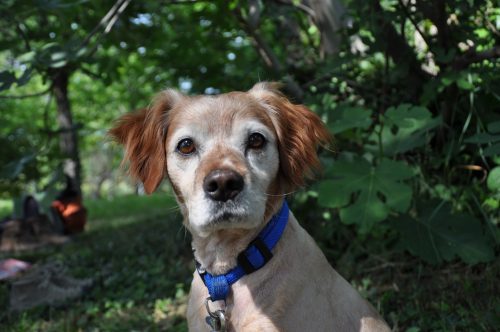When your dog has a seizure, it’s a scary event. Twitching, rolling around, panting and foaming at the mouth make your dog look like he has been poisoned, or attacked by some invisible force. As a dog owner, you will feel helpless and worried. This is because you may not know that your dog is experiencing a seizure. Different types of seizures take different forms. It’s important to know and recognize the symptoms of a dog seizure, so that you can get your dog the help he needs.
Seizures happen when there is abnormal electric activity in the brain. Different types of seizures affect different parts of the brain, and exhibit different symptoms. Here are the most common types of seizures in dogs, and the symptoms associated with each:
Generalized Seizure Symptoms
Known as Grand Mal seizures, generalized seizures affect the entire brain and body. Dogs with idiopathic Epilepsy – the most commons cause of seizures in dogs – experience generalized seizures. These seizures can last from a few seconds to a few minutes, and begin with a pre-seizure period called the aura.
During the aura period, you may notice your dog exhibiting strange behaviors, including staring into space, visible agitation and anxiety, restlessness, whining or barking, and confusion. Your dog may seek attention and cling to you during this period. If these behaviors happen individually, you might not notice anything is seriously wrong. But together, both you and your dog will be keenly aware that something is “off.”
After the aura phase, your dog will go into seizure (also called the “ictal phase”). Generalized seizures result in a variety of behaviors. Your dog will lose awareness of the environment around him – in fact, he will not have any awareness of what is happening to him at all. His limbs will become rigid, as if he is flexing his muscles.
His legs may jerk in a rhythmic manner, as if he is running or pawing at an object. He may chomp or chew – but don’t worry, he will not swallow his tongue (that’s an old wives’ tale). He may foam at the mouth, vomit, drool, and even urinate or defecate. In some cases, he may even stop breathing for a few seconds.
Remember, your dog will normally lose consciousness during seizures, and have no control over his bodily functions. While these symptoms may seem painful, your dog has no idea what is happening.
Partial Seizure Symptoms
Often called focal seizures, partial seizures affect only a portion of the brain, leading to more specific outcomes. Partial seizures result in the same types of symptoms as generalized seizures – twitching muscles, stiff limbs, chomping, chewing, etc. – but they will be localized to a single portion of the body. For instance, if your dog’s left leg is making a running motion but his right leg remains still, he is most likely suffering from a partial seizure.
Psychomotor Seizure Symptoms
A psychomotor seizure can be difficult to spot initially. Psychomotor seizures alter, but don’t take over your dog’s consciousness. During a psychomotor seizure, your dog will exhibit strange behavior – like attacking an imaginary object. A psychomotor seizure is rare, but it will be easy to spot if it happens more than once, because your dog will exhibit the exact same behavior every time a seizure strikes.
Cluster Seizure Symptoms
Dogs who suffer from idiopathic Epilepsy – the most common reason behind seizures in dogs – can experience cluster seizures, which are multiple seizures over a short period of time. Two or more seizures in a 24-hour period are considered cluster seizures. If your dog is suffering from cluster seizures, you should seek veterinary attention. While most seizures have little to no effect on a dog’s long-term health, cluster seizures can eventually lead to brain damage if they happen consistently. There are, however, several medical options to treat ongoing seizures in dogs.
What You Can Do
During a seizure, the only thing you can do for your dog is ensure that he has room to move around. Make sure there are no hard or sharp edges that he can bump into and injure himself. Otherwise, you simply must let the seizure play out.
When the seizure is complete, your dog will be disoriented and scared. The best thing you can do is hold him and comfort him. It will take some time for your dog to recover, but in less than a day he should be back to his normal self.






